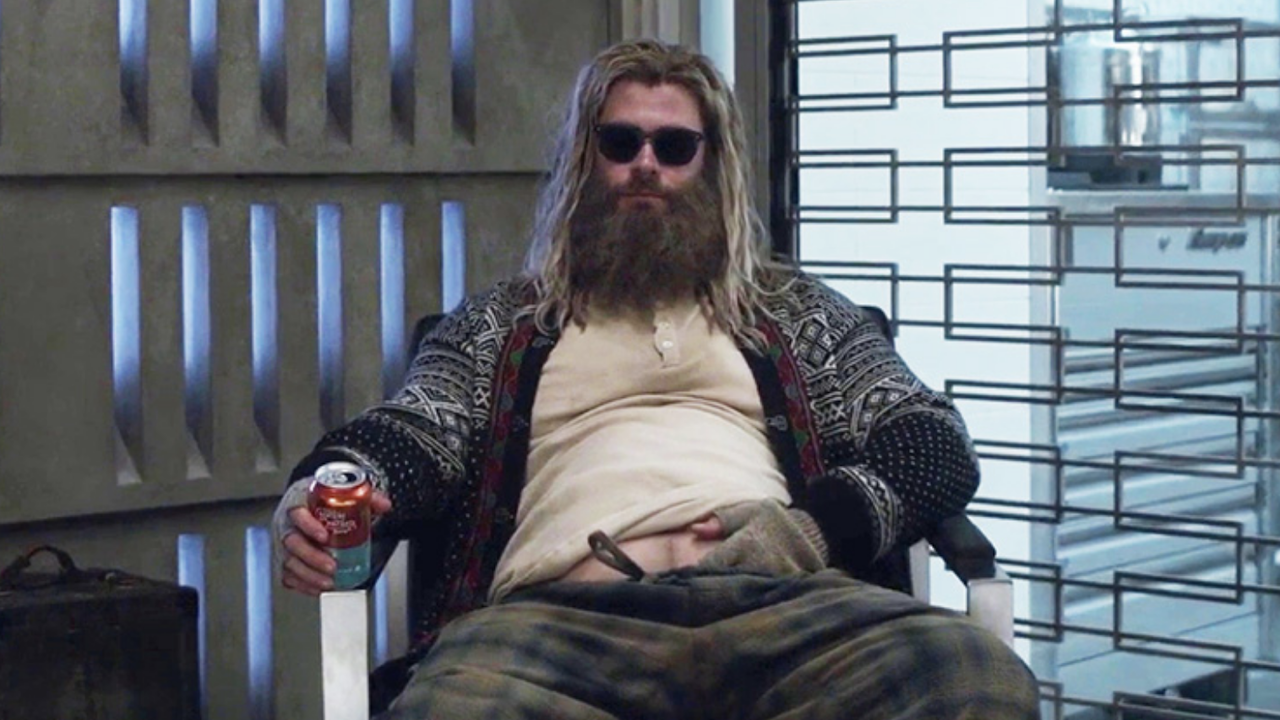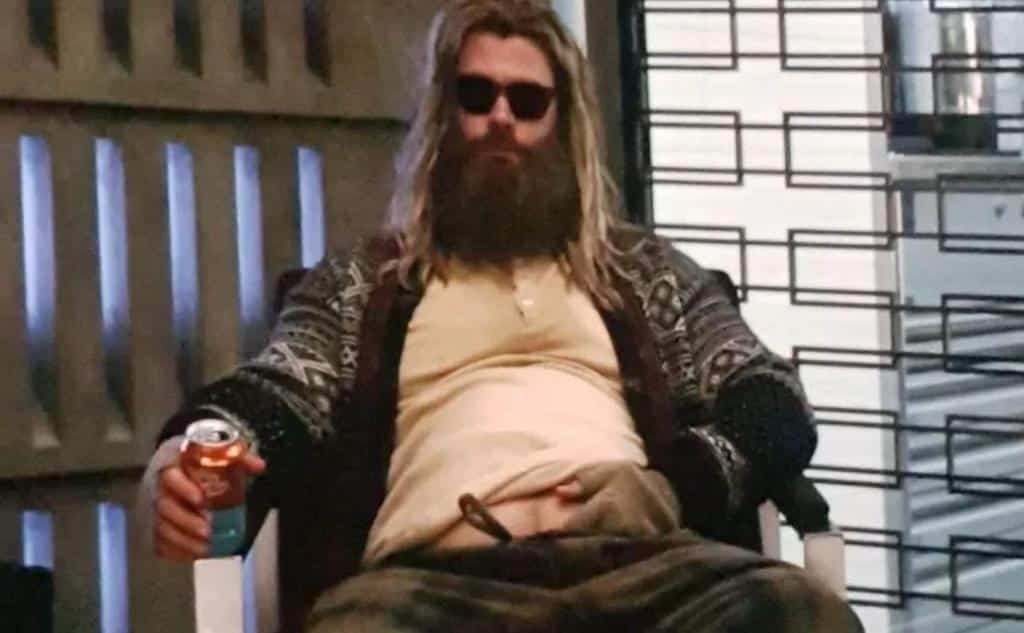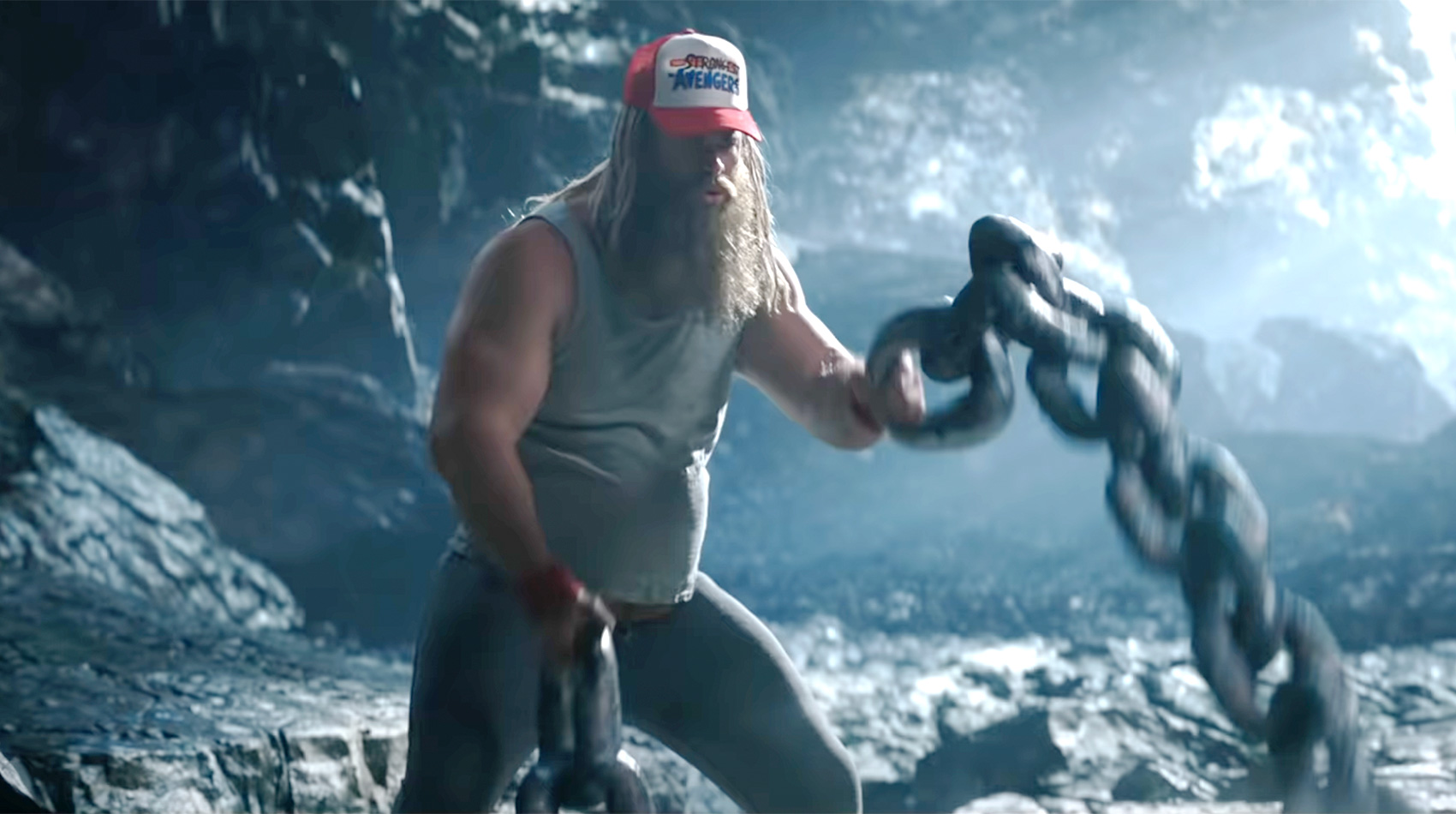The appearance of a different looking Thor in Avengers: Endgame really caught many people by surprise, and it sparked a whole lot of conversation. It was, in a way, one of the biggest talking points to come out of the movie, with folks everywhere discussing the character's unexpected physical transformation. This portrayal, affectionately called "fat thor" by many, marked a pretty significant moment for the character and the entire film series.
This particular version of Thor showed a hero grappling with a lot of personal hurt and a sense of helplessness after some truly devastating events. His altered physical state was, you know, a very visual representation of the deep emotional struggles he was going through. It was a bold choice, to be sure, and it prompted viewers to think a bit more about what a superhero's journey can truly look like, especially when facing deep personal sorrow.
The creative minds behind the movie made some interesting decisions to bring this version of Thor to the screen, and the actor who plays him even shared some thoughts on what it was like to step into those shoes. This whole portrayal, as a matter of fact, became a topic of lively debate, with some seeing it as a brilliant narrative stroke and others feeling it missed an opportunity for a different kind of storytelling. It really got people talking about the ways characters can change and grow, or perhaps, regress, when facing immense pressure.
Table of Contents
- Chris Hemsworth - The Man Behind the God
- Personal Details of Chris Hemsworth
- What Was the Vision for "Fat Thor"?
- How Did the Team Bring "Fat Thor" to Life?
- Did "Fat Thor" Miss a Chance for Deeper Exploration?
- Why Was "Fat Thor" a Smart Storytelling Choice?
- The Journey Back - "Fat Thor" No More?
- The Enduring Impact of "Fat Thor"
Chris Hemsworth - The Man Behind the God
The character of Thor Odinson, as seen in the Marvel Cinematic Universe, is brought to vivid life by the acting talents of Chris Hemsworth. For a long stretch of time, Mr. Hemsworth has been the face of this particular hero, making him a household name and a familiar figure to movie watchers all over the globe. He has really, you know, put his own mark on the god of thunder, giving him a distinct personality and a memorable screen presence that has resonated with many people.
Thor, in this cinematic telling, is presented as one of the very strong individuals from a very old alien society called Asgard. This group of beings has, for a very long time, had connections with our planet, Earth. People here on Earth, in their way of seeing things, have often thought of these Asgardians as gods, given their extraordinary abilities and their long, long lives. It's a pretty fascinating concept, that these powerful beings from another place could be mistaken for deities by us, isn't it?
Chris Hemsworth's performance has been a central part of how fans have connected with Thor. He has shown the character go through many different stages, from a somewhat arrogant prince to a more thoughtful, if still quite formidable, leader. This long-term portrayal has really allowed audiences to see the various sides of Thor, including moments of triumph and, as we'll discuss, some pretty deep personal setbacks. It's almost like watching a person grow and change over many, many years, you know, just on a much grander scale.
Personal Details of Chris Hemsworth
Here are some general details about the person who brings Thor to the screen:
| Detail | Information |
|---|---|
| Full Name | Christopher Hemsworth |
| Known For | Portraying Thor in the Marvel Cinematic Universe |
| Key Appearances as Thor | Avengers: Endgame, Thor: Ragnarok, Avengers: Infinity War, Thor: Love and Thunder, and others |
| Character Name | Thor Odinson |
| Character's Origin | Based on the Marvel Comics character and the Norse mythological god of thunder |
What Was the Vision for "Fat Thor"?
The appearance of "fat thor" in Avengers: Endgame was, you know, a pretty closely guarded secret before the movie came out. It was one of those big surprises that the filmmakers really wanted to keep under wraps until audiences actually saw it for themselves. When the character did show up looking quite different, it definitely caused a stir, and people quickly started using the phrase "fat thor" to talk about his new look. It was a very striking visual change, that's for sure, and it made an immediate impression on everyone watching.
This particular visual change was meant to show a hero in a state of deep emotional struggle. After the very sad events of Thanos's snap, and losing almost everything important to him in Infinity War, Thor was going through a period of significant sadness and mental distress. His physical appearance was, in a way, a direct reflection of this inner turmoil. It was meant to convey that he wasn't just physically tired, but truly burdened by the heavy weight of his experiences and losses. You could say it was a visual shorthand for his internal pain, making it very clear to the audience what he was feeling.
The idea behind this portrayal was to show a hero who wasn't just physically strong, but also vulnerable and capable of breaking down under pressure. It was a departure from the typical superhero image, which often shows characters as always being in peak physical condition, no matter what they go through. This choice for "fat thor" aimed to present a more human side to a god-like figure, showing that even someone as powerful as Thor could be affected by intense sorrow and a sense of failure. It was, perhaps, a way to make him more relatable to regular people, who also face tough times and personal struggles.
How Did the Team Bring "Fat Thor" to Life?
Bringing this version of Thor to the big screen involved some very practical and clever methods. The actor, Chris Hemsworth, wore a special suit to give him the larger body shape, and other items were used to complete the look. It wasn't just about putting on a costume; it was about creating a believable visual change for a character that audiences had known for a very long time in a completely different physical form. This practical approach meant that the physical presence of this "fat thor" felt quite real, which helped sell the story of his emotional state.
Chris Hemsworth himself spoke about what it was like to play this very different version of Thor. He mentioned that it felt quite freeing to do something new with the character, that it was a lot of fun, and even that it was a bit exciting. For an actor who had played the same role for many years, taking on such a noticeable physical and emotional shift could be, you know, a really interesting challenge. It gave him a chance to explore a side of Thor that audiences had never seen before, moving away from the usual heroic image and into something much more grounded and, in a way, more human.
There was, it seems, a very clear reason behind this unusual choice for the character. The creators had a specific purpose in mind for why Thor appeared this way, especially after the events of Infinity War where he had lost so much. This wasn't just a random change; it was a deliberate storytelling decision meant to show the aftermath of profound personal loss and struggle. It was, you could say, a way to visually represent the heavy emotional burden Thor was carrying, making his personal pain visible for everyone to see. It was, apparently, a very thought-out approach to character development.
Did "Fat Thor" Miss a Chance for Deeper Exploration?
Some people felt that the movie used Thor's weight gain as a quick joke, a way to poke fun at his strength and his traditional image as a powerful hero. There was a feeling that this change, while visually striking, sometimes served as a source of easy laughs rather than a serious look at his struggles. This perspective suggests that the film might have missed a chance to treat the character's new appearance with more seriousness, perhaps leaning too much into comedy when a more somber approach could have been taken. It's a point of view that really highlights the tension between humor and a deeper narrative.
A number of critics and viewers expressed the opinion that this portrayal was a lost opportunity to really dig into topics like mental well-being and dealing with very difficult personal habits in a truly complex and delicate manner. They thought that instead of just showing the physical change and making it part of the comedy, the movie could have spent more time showing the true difficulties of what someone goes through when dealing with very low spirits or trying to cope with personal pain in unhealthy ways. It was, in some respects, seen as a chance to add more layers to the story, making it more impactful and perhaps more relatable for people who have faced similar challenges in their own lives.
This viewpoint argues that while the visual change was bold, the way it was handled could have been, you know, a bit more thoughtful. If the film had spent more time showing the internal struggle and the path to coping, rather than just the outward appearance, it might have resonated differently with audiences. It's a discussion about how stories can responsibly portray sensitive topics, especially when dealing with a character who has been a symbol of strength and resilience for so long. It suggests that a different approach could have led to a more profound message about overcoming personal difficulties.
Why Was "Fat Thor" a Smart Storytelling Choice?
On the other hand, many people saw "fat thor" as a really clever move for Marvel's hero, especially since he was dealing with such deep sadness and a feeling of being powerless after Thanos's big action. This perspective suggests that the change wasn't just for laughs, but served a very important purpose in the story. It was a way to show, very clearly, how much the character had been affected by everything he had been through, making his emotional state very visible to everyone watching. This approach, you know, helped ground a god-like character in a very human experience.
The idea that Thor had put on a lot of weight was seen by many as fitting perfectly with his character's journey, adding to the moments of humor, and setting the stage for his eventual return to a more heroic self within the larger story. It showed that even a powerful being could fall into a slump, feel the weight of his failures, and struggle to find his way back. This visual change, in a way, made his eventual recovery and return to form feel much more earned and meaningful. It added a layer of realism to his personal struggles, making him feel more like a person with real problems, rather than just an invincible god.
This portrayal was also thought to be an excellent way to show the character's feelings of uncertainty and his deep sadness. When you see Thor looking so different, it immediately tells you that he is not in a good place, mentally or emotionally. It communicates his internal struggles without needing a lot of talking or explaining. This visual storytelling technique was, perhaps, a very effective way to convey the depth of his pain and how truly lost he felt after losing so much in the previous movie. It made his doubt and depression very clear, giving the audience a strong sense of his inner world.
The Journey Back - "Fat Thor" No More?
For those who had grown accustomed to the "fat thor" appearance, the trailers for a later movie, Thor: Love and Thunder, showed a significant shift. Chris Hemsworth's superhero character was seen to have shed the extra weight he had gained during the events of Avengers: Endgame. This visual return to a more familiar physique marked a new chapter for the character, suggesting a move away from the personal struggles that had defined his appearance in the earlier film. It was, you know, a clear sign that his journey of recovery had progressed.
The phrase "fat thor is no more" became a common way to describe this change, acknowledging that the character had moved past that particular phase of his life. This transformation indicated that Thor had, in some way, worked through some of his sadness and trauma, or at least was on a path to doing so. It showed a character who was perhaps regaining his sense of purpose and his former strength, both physically and mentally. This shift was, apparently, a welcome sight for many who preferred to see Thor in his more traditional, physically imposing form.
This physical change also hinted at the character's readiness for new adventures and challenges, leaving behind the period of deep personal reflection and sadness. It suggested that the narrative arc of his struggle had reached a point of resolution, or at least a significant turning point. The return to his previous appearance was, in a way, a visual cue that Thor was once again ready to face the world as the mighty god of thunder, perhaps with new wisdom gained from his difficult experiences. It was a clear signal of his personal and heroic renewal.
The Enduring Impact of "Fat Thor"
The character's appearance as "fat thor" sparked numerous discussions and became a frequent point of reference in conversations about the 2019 Marvel superhero film, Avengers: Endgame. It was a moment that stuck with people, becoming a memorable part of the movie's legacy. This particular portrayal really got people talking, both about the character's personal journey and the choices made by the filmmakers. It's almost as if it became a shorthand for a certain period in the character's life, a very distinct chapter.
The fact that a specific video, titled "Fat Thor being fat thor for 4.6 minutes straight yesterday," gathered a significant number of viewers, with 2.47 thousand people subscribed to the channel, really shows how much interest and discussion this particular version of the character generated. This kind of engagement highlights that the portrayal wasn't just a fleeting moment in the movie; it resonated with a lot of people and sparked a genuine desire to revisit and discuss it. It's a pretty clear sign that this version of Thor left a lasting impression on the audience, sparking conversations and even dedicated fan content.
The unexpected twist of making Thor appear heavier in Endgame was, in the end, a really effective way to show the character's feelings of doubt and his deep sadness. It was a visual choice that communicated a lot without needing a ton of words, making his internal struggles very clear to everyone watching. This creative decision, you know, gave a lot of depth to the character, showing that even a god can experience profound human emotions and personal struggles. It was, basically, a very clever piece of storytelling that added a lot of weight, no pun intended, to Thor's personal journey.
The entire storyline around "fat thor" from his surprising introduction in Avengers: Endgame to his eventual return to a different physique, truly highlighted a period of deep personal struggle for the character. This portrayal, brought to life with practical effects and Chris Hemsworth's commitment, sparked a lot of discussion, with some seeing it as a missed chance for a more serious look at mental well-being, while others praised it as a brilliant way to show a hero's pain and journey toward recovery. It certainly left a lasting mark on the film series and on the character's story.
Related Resources:



Detail Author:
- Name : Damion Adams DVM
- Username : breitenberg.hans
- Email : ijast@hirthe.com
- Birthdate : 1979-01-11
- Address : 7439 Gerlach Point Suite 650 South Delaney, HI 33315
- Phone : (415) 694-2534
- Company : Swift-Dickens
- Job : Materials Inspector
- Bio : Minima quia itaque perferendis quam earum laudantium atque. Officiis expedita laborum asperiores eum soluta quidem magnam. Ea culpa nobis est iste.
Socials
tiktok:
- url : https://tiktok.com/@ritchie2012
- username : ritchie2012
- bio : Consequuntur aut ut quibusdam et quos facilis sed. Odit iure ratione nisi.
- followers : 1194
- following : 2186
facebook:
- url : https://facebook.com/jamison8596
- username : jamison8596
- bio : Nam asperiores qui suscipit quasi velit ut distinctio.
- followers : 2773
- following : 967
linkedin:
- url : https://linkedin.com/in/ritchiej
- username : ritchiej
- bio : Eos aspernatur ea est et quo.
- followers : 5079
- following : 2918